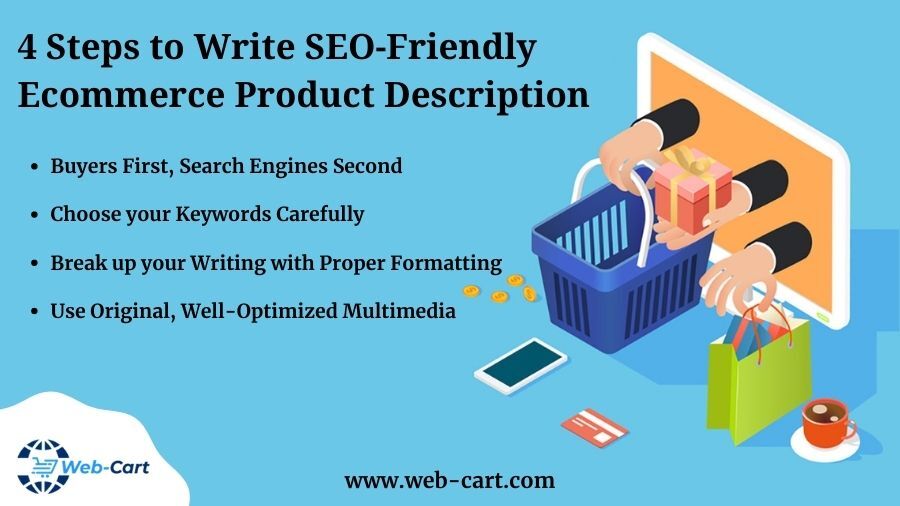
4 Steps to Write SEO-Friendly eCommerce Product Description
What’s the secret to attract the right customers to your eCommerce platform? While pay-per-click ads and link-building may help you generate leads, these are expensive tactics compared to product description optimization. Based on Smart Insights, 81% of people search for products/services through search engines such as Google and choose which online storefronts to visit through SERP. Data by Small Biz Genius also suggests that 61% of online marketers focus heavily on organic SEO, given that 70-80% of users ignore paid ads. Writing SEO-friendly product descriptions for your eCommerce storefront can help your business find its audience more easily than traditional digital marketing ever could. Let’s look at how you can do that and the benefits of adopting an SEO-friendly approach to writing for eCommerce in 2021.
Advantages of Writing SEO-Friendly eCommerce Product Descriptions
What’s the upside of writing SEO-friendly content for your online store? According to the SEO Tribunal, 39% of all global eCommerce traffic comes from search engines, with SEO driving 93% of all web traffic. Search Engine Optimization (SEO) represents the de facto trend when it comes to optimizing content for global search engines. This is due to Google’s goals to eliminate as much spam from its SERP, effectively setting the standards for other engines and websites to follow. It’s where SEO tools such as SEM Rush, Google AdWords, and Ahrefs come into play as they can help make your writing more SEO-friendly. Using such tools and rethinking how you write content for each product on your storefront can lead to several significant benefits for your brand:
- Higher industry brand awareness and store reputation
- Better overall quality of written content throughout your website
- Improved customer loyalty and word of mouth
- Easier audience segmentation with keyword targeting
- Streamlined browsing and shopping experience
- Dramatically lowered marketing expenses and ROI
Writing SEO-Friendly Content for eCommerce – The Steps to Follow
- Buyers First, Search Engines Second: Even though SEO will significantly improve your odds of finding the right customers quickly, your content should be written for people first and foremost. The benefit of doing so lies in Google’s contextual SEO, which ranks links and writing based on a balance of original writing and SEO keywords. Don’t make the mistake of searching for your industry’s keywords and stuffing the writing with trending words and phrases without rhyme or reason. Your writing skills, combined with the above-mentioned SEO tools and reviews of best writing services, will ensure that your content is of high quality through-and-through. Write your product descriptions as you normally would, and then optimize your writing per SEO standards.
- Choose your Keywords Carefully: When choosing which keywords to integrate into your product descriptions, you need to think about the buyer’s intent. Specifically, how will your target audience search for the products hosted on your eCommerce storefront? These typically fall into three categories and require slightly different approaches to writing:
Informational – the user might search for “Where can I get a new microwave?”
Navigational – the user will search for specific brands, i.e., “Where can I find a Philips microwave?”
Transactional/Commercial – the user will use purchase-oriented words, “Where can I buy a microwave?”
As you can see, the three types of searches, while similar, adopt a slightly different writing style. Choosing how to approach your product description writing will determine which users will have an easier time finding your storefront than others. Settle on a writing style and use the same keywords and formatting approach throughout your website to create a uniform customer experience for your visitors. - Break up your Writing with Proper Formatting : In order for your product descriptions to display properly on both desktop and mobile platforms, you should format the writing as best as you can. Don’t make your product descriptions too long, as they should be kept around 300-400 words in total. You should cover the basics of your product: its dimensions, materials, practical application, and any testimonials or reviews you might want to highlight. Anything over that and your descriptions will look like short essays on why the product is a good choice for the buyer. Once you have written the description entirely, you should break it up into short paragraphs and use bullet points, numerals, and text formatting liberally. You can use Web-Cart to manage your products and checkouts throughout the website and have access to unique design templates. Make your content easy to read, and far more customers will be convinced to buy your products as a result.
- Use Original, Well-Optimized Multimedia : The value of good multimedia for your eCommerce platform cannot be overstated. While using brand-specific stock images and videos might be good for a start, using original photos and demos is a much better choice. Pairing your SEO writing with solid multimedia content will make your storefront more appealing to both desktop and mobile users. Any multimedia you upload to your platform should be optimized for a balance of quality and size. If your files are too large, users with slow internet and data caps may be inclined to visit other platforms instead of your own. Too small, and your multimedia will be of poor quality and reflect badly on you as an online store owner. Adding Alt text tags to each piece of multimedia will mitigate the issue, however, and ensure that your content is still SEO-friendly regardless of device.
Adopting a Smarter Approach to SEO-Friendly Content (Conclusion)
Changing how you write content for your platform overnight is a big undertaking. However, by adopting a more systematic, SEO-friendly approach to writing product descriptions, your links will rank better in SERP than ever before. Focus on writing solid, personalized content first and foremost before adding keywords, phrases, and alt tags to your products. By combining both, you will stand a far better chance at generating new leads and making smart use of SEO tools at your disposal.